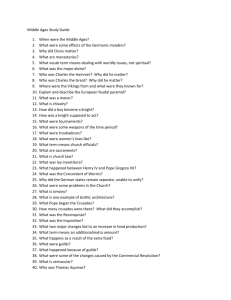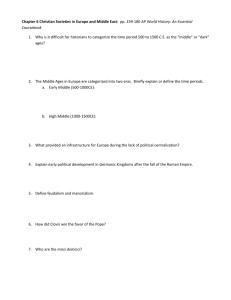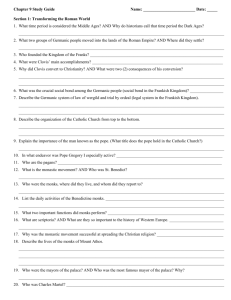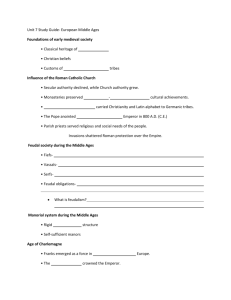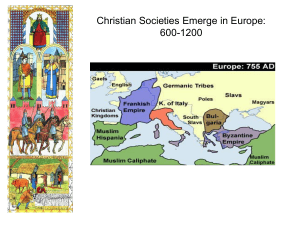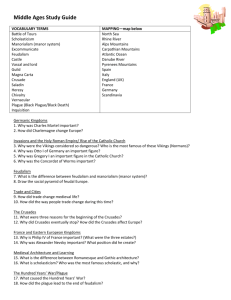Raiders, Traders and Crusaders: Western
advertisement
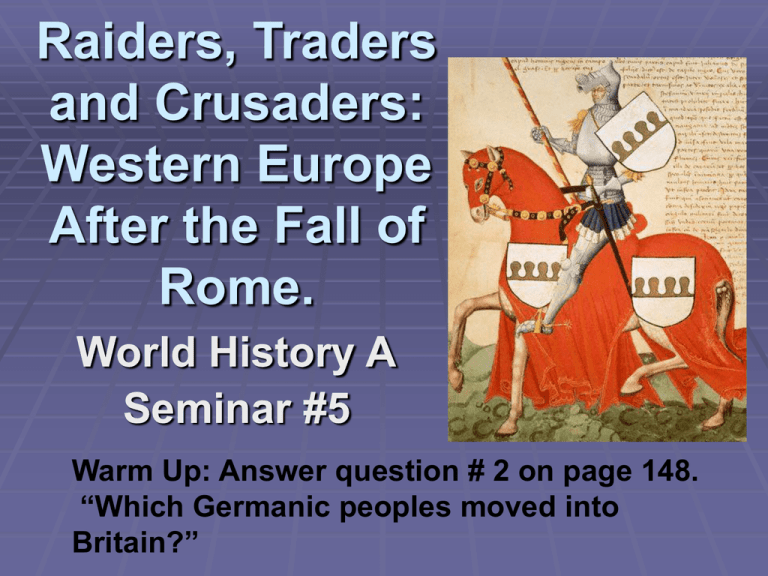
Raiders, Traders and Crusaders: Western Europe After the Fall of Rome. World History A Seminar #5 Warm Up: Answer question # 2 on page 148. “Which Germanic peoples moved into Britain?” Warm Up Question: Answer Answer question # 2 on page 148. “Which Germanic peoples moved into Britain?” Angles, Saxons and Jutes Click on red underlined words in this presentation to follow the hyperlink to more information. Vikings: The Raiders In the period from 800 to 1050 A.D., the Nordic peoples made their dramatic entry into the European arena. They stormed forth, terrorizing well established societies which were accustomed to war, but not to the startling tactics of the Vikings. They even sailed as far west as North America. Vikings: The Raiders Click on the map for an excellent interactive site about Vikings The Rise of Europe 500-1300 (Textbook: page 183) The Early Middle Ages During the early Middle Ages, Europe was a relatively backward region cut off from the advanced civilizations of Byzantium, the Middle East, China and India. Between 700 and 1000, Europe was battered by invaders. Slowly a new civilization would emerge that blended Greco-Roman, Germanic and Christian traditions. The Rise of Europe 500-1300 From World History: Connections to Today Prentice Hall, 2003 Kingdom of the Franks 400-768 Franks invaded Gaul in the area now called France. (400-700) Frankish King Clovis (486) first to conquer Gaul. Clovis converted to Christianity and brought the religion to the region. Frankish King Charles Martel (732) kept Muslim invaders from Spain out of France. Stopped spread of Islam in Europe at the Battle of Tours. From World History: Connections to Today Prentice Hall, 2003 Empire of Charlemagne 768-843 Loved battle Christian emperor. 800 aided Pope Leo III put down rebellious nobles in Rome. Pope Leo III crowned Charlemagne “Emperor of the Romans.” Cemented Christian rule in Europe. Outraged Byzantine Emperor who saw himself as Roman successor. From World History: Connections to Today Prentice Hall, 2003 Legacy of Charlemagne (Holy Roman Empire) Revival of Latin Click on the picture for web link. learning Extended Christian civilization into northern Europe Set up strong, efficient governments. Began Holy Roman Empire. (Germany) Could not repel further Viking and Magyar invasions. Feudalism Textbook: page 186 - 192 Define Feudalism. Feudalism: loosely organized system of government in which local lords governed their own lands but owed military service and other support to a greater lord. Click on the picture for information on feudal life Feudalism Textbook: page 186 - 192 Characteristics Nobles Peasants Monks/Nuns Obligations •Military Service to Lord Rights and Benefits • Protection by Lord • Life of Religious Lives Service Use your textbook to complete the chart. Traders in Medieval Europe 1000-1300 (Textbook: page 198) o Advanced agricultural techniques: harness, windmill, crop rotation – improved lifespan and increased population o Trade revived with new trade routes o Trade fairs and guilds appeared. Define “guild” o Guild – association of merchants or artisans who cooperated to protect their economic interests. Traders in Medieval Europe 1000-1300 (Textbook: page 198) From World History: Connections to Today Prentice Hall, 2003 High Middle Ages 1050-1450 Textbook, page 206 Feudal monarchies headed William of Normandy Norman ship European society, but had little power. Angles, Saxons and Vikings invaded and settled in England. 1066 - Anglo Saxon king of England, Edward died. William of Normandy, Edward’s brother in law, invaded England and took control at Battle of Hastings. French was spoken in the English court for the next 200 years. Foundation of English Common Law 1066 - William I creates Domesday Book for purposes of fair tax collection. 1154 - Henry II broadened system of royal justice. Laid the foundation for English Legal system. Began English Common Law. Define “common law” Common law - a legal system based on custom and court rulings. King John I signs Magna Carta which limited the power of the king. Magna Carta - 1215 No royal official shall take goods from any man without immediate payment. No free man shall be imprisoned Due Law of his except by Process the lawfulof judgment equals or by the law of the land. In future no official shall place a man on trial without producing credible witnesses. Courts shall be held in a fixed place at a fixed time. The barons shall elect a House of Lords for the creation of laws. The English church shall be free. For a trivial offence, a free man shall be fined only in proportion to the degree of his offence. The Crusades 1050s – Seljuk Turks invade Byzantine Empire. Extend power over Palestine to the Holy Land and attack Christian pilgrims 1095 – Byzantine Emperor Alexius I asks Pope Urban for help in ridding his empire of Muslim invaders. Pope Urban agrees to help. Hopes to consolidate his own power, end schism between Rome and Constantinople and keep Christian knights from fighting one another. Click on the picture for a link to the Crusades. The Crusades 1099 – Christian knights capture Jerusalem. 1187 – Muslim soldiers under Saladin recapture Jerusalem. 1198 – Pope Innocent III takes office. Claims supremacy over all other rulers. The Church becomes the most powerful body in Europe. Crusades continue for next 200 years. The Crusades From World History: Connections to Today Prentice Hall, 2003 Effects of the Crusades on Europe Economic expansion – increased trade with the Middle East and Byzantine Empire Growth of Italian trading families. Growth of money economy Increased power of the monarchs. Increased power of the Church Wider world view Reconquista in Spain – Muslims and Jews forced to leave or convert. The Final Invader – The Black Death The Black Death was one of the worst natural disasters in history. In 1347 A.D., a great plague swept over Europe, ravaged cities causing widespread hysteria and death. One third of the population of Europe died. "The impact upon the future of England was greater than upon any other European country." (Cartwright, 1991) The primary culprits in transmitting this disease were oriental rat fleas carried on the back of black rats . Frederick F. Cartwright, DISEASE AND HISTORY, Dorset Press, New York, 1991, p. 42. The Final Invader – The Spread of the Black Death The Final Invader – The Black Death "The first signs of the plague were lumps in the groin or armpits. After this, livid black spots appeared on the arms and thighs and other parts of the body. Few recovered. Almost all died within three days, usually without any fever." The Final Invader – The Effects of the Black Death In Medieval England, the Black Death was to kill 1.5 million people out of an estimated total of 4 million people between 1348 and 1350. No medical knowledge existed in Medieval England to cope with the disease. After 1350, it was to strike England another six times by the end of the century.
